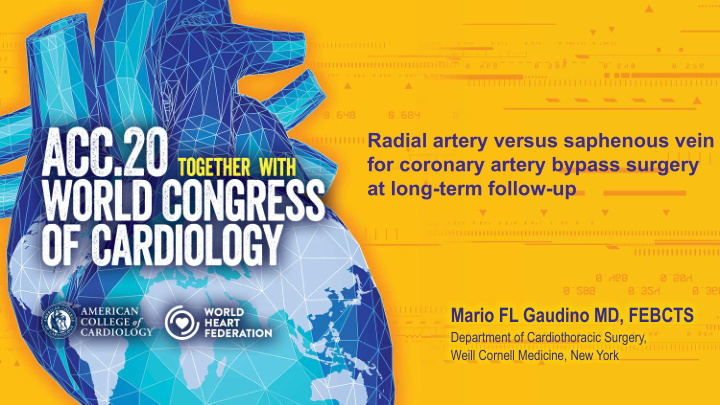



Radial artery versus saphenous vein for coronary artery bypass surgery at long-term follow-up Mario FL Gaudino MD, FEBCTS Department of Cardiothoracic Surgery, Weill Cornell Medicine, New York
DISCLOSURES NONE
BACKGROUND • Observational studies suggest that the use of radial artery grafts (RA) for coronary artery bypass (CABG) may improve outcomes compared with use of saphenous vein grafts (SVG) • The Radial Artery Database International Alliance (RADIAL), a patient-level meta-analysis of five randomized trials, reported a reduction in cardiac events at 5 years, but without difference in survival • The 5-year analysis was likely underpowered and possibly driven by revascularization following protocol mandated angiography
Details of the trials included Petrovic RAPCO RSVP Nasso Song Study period (enrollment) 2001-2003 1997-2004 1998-2000 2003-2006 2008-2009 Country of origin Serbia Australia United Kingdom Italy South Korea Total number of patients 200 225 142 409 60 Age (overall), years (Mean±SD) 56.4±6.1 72.8±4.7 58.5±6.7 70.3±7.7 75.7±5.4 Females (overall) (%) 27.0 19.1 3.5 43.0 50.0 RA: 39 (39) RA: 27 (37) RA: 15 (18) RA: 73 (36.1) RA: 15 (42.9) Diabetes, n (%) SVG: 43 (43) SVG: 37 (46) SVG: 10 (17) SVG: 77 (38.1) SVG: 13 (52.0) RA target vessel stenosis (%) >80 >70 >70 >70 NR % of RA grafts to the circumflex coronary artery 83 100 100 47 98 Crossover rate (%) 0.0 3.6 0.0 4.2 0.0
METHODS Ø Clinical follow-up to 10 years or to the maximal possible follow-up for each patient was requested from the individual trials’ teams Ø Follow-up was performed by telephone interview for Nasso, RAPCO and Petrovic trials Ø For the Radial Artery Versus Saphenous Vein Patency (RSVP) trial, the Royal Brompton & Harefield NHS Foundation Trust electronic patient record database and questionnaires sent to general practitioners were used Ø For the Song trial, the Statistic Korea database as well as telephone interviews were used
METHODS Ø The primary outcome was a composite of death , myocardial infarction and repeat revascularization Ø The secondary outcome was a composite of death and myocardial infarction Ø Death was not a pre-specified outcome, and was analyzed post-hoc Ø A mixed-effect Cox regression model was used Ø The median follow-up time was 10 years in both groups (1st-3rd quartile 10-11) Ø 942/1036 (90.9%) of patients had a follow-up of at least 10 years
Baseline characteristics of the patients Radial Artery Graft Group Saphenous Vein Graft Group P value (N=534) (N=502) Age, mean (SD) 66.6 (9.3) 67.1 (9.8) 0.42 Male, n(%) 376 (70.4) 351 (69.9) 0.92 Diabetes, n(%) 181 (33.9) 177 (35.3) 0.69 Prior myocardial infarction, n(%) 164 (30.7) 160 (31.9) 0.74 Elective admission, n(%) 469 (87.8) 456 (90.8) 0.14 Renal insufficiency, n(%) 45 (8.4) 46 (9.2) 0.76 Left ventricular ejection fraction <50%, n(%) 70 (13.1) 64 (12.7) 0.93 Target vessel 0.13 Left circumflex coronary artery, n(%) 415 (77.7) 369 (73.5) Right coronary artery, n(%) 119 (22.3) 133 (26.5) N of grafts, mean (SD) 3.1 (0.7) 3.1 (0.6) 0.53 Proximal Anastomosis site 0.10 Ascending aorta, n(%) 489 (91.5) 474 (94.4) Internal thoracic artery, n(%) 45 (8.5) 28 (5.6)
Cumulative incidence of the primary composite outcome in the RA vs SVG groups
Cumulative incidence of the secondary composite outcome in the RA vs SVG groups
Cumulative incidence of death in the RA vs SVG groups
Cumulative incidence of Myocardial infarction (left) and Repeat revascularization (right) in the RA vs SVG group
Subgroup analysis and interaction terms for the primary composite outcome of Death, Myocardial infarction, or Repeat revascularization
Time segmented analysis for repeat revascularization (left panel: events in the first five years of follow-up, right panel: events after the fifth year of follow-up)
Time segmented analysis for the composite of death, myocardial infarction or revascularization (left panel: events in the first five years of follow-up, right panel: events after the fifth year of follow-up)
Main outcomes Radial Artery Graft Group Saphenous Vein Graft Group Treatment effect* (N=534) (N=502) No. of Events per Cumulative incidence No. of Events Cumulative incidence Hazard ratio P value events 1000 at 10 and 15 years events per 1000 at 10 and 15 years (95%CI) (%) patient- (%) patient- years† years† Death, myocardial 220 10y 31.0%(27.0-34.9) 237 10y 41.6%(37.2-46.0) infarction, or repeat 41 47 0.73 (0.61-0.88) <0.001 (41.2) 15y 52.5%(46.1-58.9) (47.2) 15y 61.5%(54.5-68.6) revascularization Death or myocardial 188 10y 25.4%(21.6-29.1) 193 10y 33.0%(28.8-37.3) 35 38 0.77 (0.63-0.94) 0.01 infarction (35.2) 15y 47.8%(41.2-54.5) (38.4) 15y 57.1%(49.5-64.7) 128 10y 14.0%(11.1-17.0) 134 10y 19.8%(16.2-23.4) Death 24 27 0.73 (0.57-0.93) 0.01 (24.0) 15y 34.6%(28.2-41.0) (26.7) 15y 47.1%(38.9-55.3) 72 10y 12.0%(9.2-14.7) 81 10y 15.6%(12.3-18.8) Myocardial infarction 13 16 0.74 (0.54-1.02) --- (13.5) 15y 15.2%(11.6-18.7) (16.1) 15y 19.3%(14.8-23.8) Repeat 63 10y 11.3%(8.6-14.0) 86 10y 16.4%(13.2-19.7) 12 17 0.62 (0.45-0.86) ---- revascularization (11.8) 15y 11.8%(8.9-14.6) (17.1) 15y 18.2%(14.4-22.0) * Results from mixed effect Cox regression model with individual trials included as a random effect (Saphenous Vein Graft Group is the reference group)
CONCLUSIONS Ø In this individual participant data meta-analysis with a median follow up of 10 years, among patients undergoing CABG, the use of the radial artery compared with saphenous vein grafts was associated with a lower risk of a composite of cardiovascular outcomes and a better survival Ø This is the first report of a survival benefit for CABG using multiple arterial conduits based on randomized data
THANK YOU
Recommend
More recommend